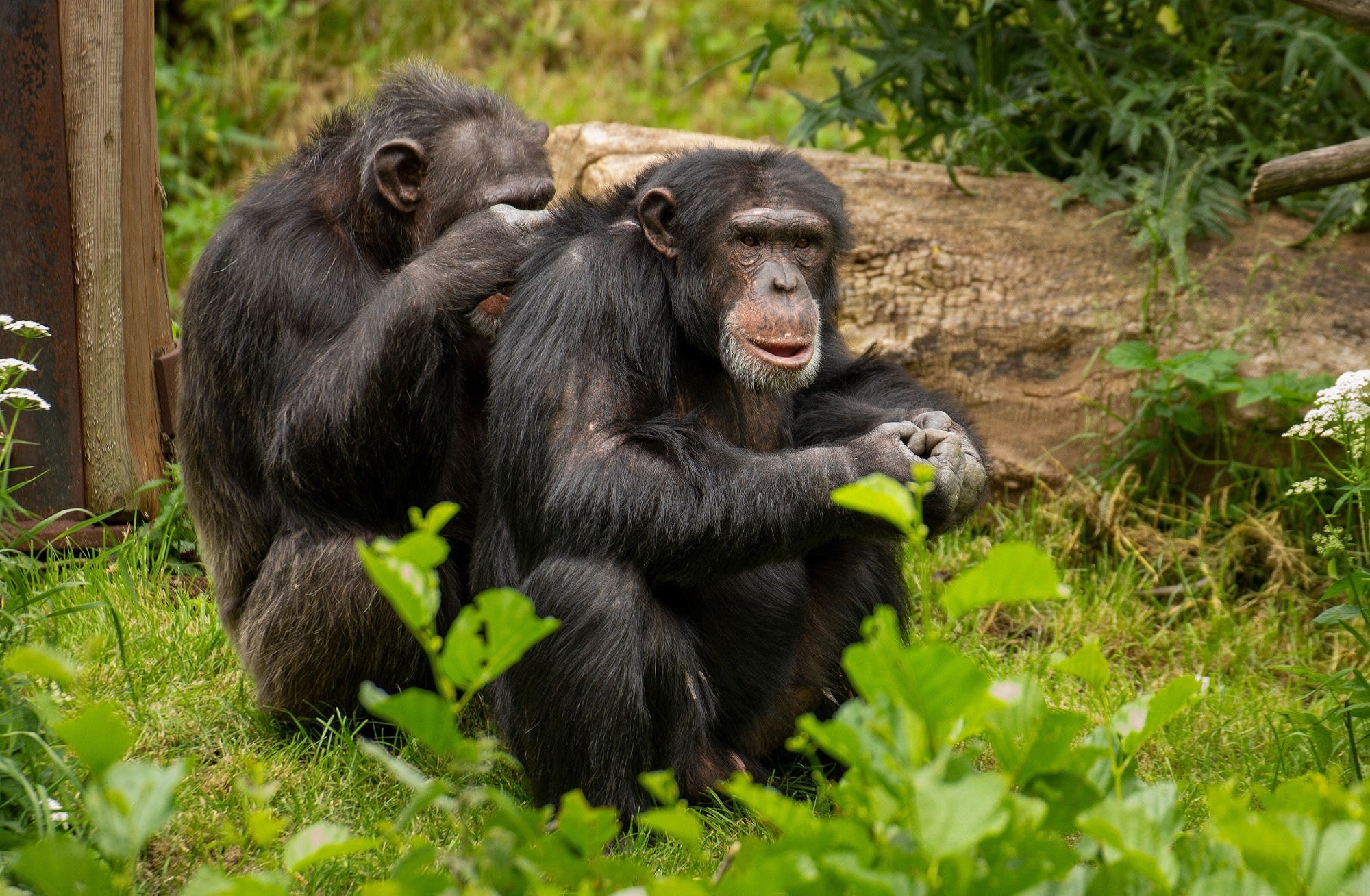.jpg) By Dr. Chinta SidharthanReviewed by Lexie CornerNov 27 2024
By Dr. Chinta SidharthanReviewed by Lexie CornerNov 27 2024In a recent study published in PLOS ONE, researchers from Durham University investigated the behavioral contagion of grooming and play among sanctuary-living chimpanzees in Zambia. The study examined how these behaviors spread within the group and identified the individual and social factors influencing this process.

Image Credit: BigDane/Shutterstock.com
Background
Social animals like chimpanzees engage in behaviors like grooming and play to maintain group cohesion. The ability to recognize and respond to the behaviors of conspecifics is fundamental for social living and group dynamics. Behavioral contagion, where individuals mimic observed behaviors, is key in fostering group cohesion and social bonding.
While behavioral contagion has been extensively studied in neutral or negative contexts, such as vigilance and self-scratching, less attention has been given to positive affiliative behaviors, such as grooming and play, despite their importance in forming and maintaining social bonds. Grooming in primates reduces tension and strengthens alliances, while play supports social integration and skill development, particularly among juveniles.
Although grooming contagion has been observed in species like macaques, evidence for play contagion in primates remains limited, leaving a significant gap in understanding the spread of positive social behaviors.
About the study
This study aimed to address the gap in knowledge regarding behavioral contagion in primates by investigating whether chimpanzees, known for their complex social structures, exhibit contagion for affiliative behaviors such as grooming and play. The researchers also explored the factors influencing this phenomenon.
The study was conducted at the Chimfunshi Wildlife Orphanage in Zambia and involved observations of 41 chimpanzees aged three years and older over a two-month period. Behavioral observations followed a post-observation/matched control method, comparing chimpanzee actions after witnessing grooming or play to control periods where no such behaviors were observed.
The researchers recorded behaviors within a five-minute window after the initial exposure to ensure direct observation. Grooming or play contagion was identified if the observing chimpanzee initiated a similar behavior within this period. Control observations were conducted in comparable social contexts without prior exposure to the target behaviors.
To quantify social relationships, the researchers employed scan sampling to measure proximity, grooming, and play interactions among dyads. Social closeness was further assessed using the Dyadic Sociality Index (DSI). Additional data included individual characteristics such as age, sex, and dominance rank obtained from veterinary records and caretaker input.
The analyses included the use of General Linear Mixed Models (GLMMs) to evaluate the occurrence of grooming and play contagion and to identify individual and social predictors of this phenomenon.
Fixed effects included social closeness, age, sex, and rank, while controls accounted for the time of day, individual tendencies toward the behavior, and group size during observations.
Observations were analyzed for the latency and frequency of contagion initiation to gain insights into how quickly and under what conditions the behaviors were imitated.
Major findings
The researchers found that affiliative behaviors such as grooming and play were contagious among chimpanzees, spreading within the group after observation. Grooming contagion was more likely to occur between socially close individuals, emphasizing the role of strong social bonds. In contrast, play contagion was observed more frequently among younger chimpanzees, highlighting developmental differences in social behavior.
Grooming was initiated more often after observing others groom, but latency analyses showed that responses were not immediate. Most grooming behaviors were initiated within the first minute of observation. Social closeness significantly influenced grooming contagion, suggesting that strong bonds facilitate behavioral mimicry. However, age, sex, and dominance rank did not significantly affect the likelihood or timing of grooming contagion.
Play contagion, on the other hand, exhibited distinct patterns. It was more common among juveniles and subadults, with younger individuals initiating play more quickly after observation compared to adults. Unlike grooming, social closeness did not significantly impact play contagion. The researchers suggested that the spontaneous and interactive nature of play may override social biases.
A key finding was that play behaviors were mimicked more rapidly than grooming, with a median latency of 18 seconds for play compared to 77 seconds for grooming. This indicates that play contagion requires less social and cognitive processing. Additionally, individual differences in tendencies toward grooming and play influenced the likelihood of contagion, reflecting inherent behavioral predispositions.
Conclusions
The study demonstrated that grooming and play behaviors are contagious in chimpanzees, with distinct influences of social closeness and age on both behaviors. While grooming contagion strengthens social bonds among close partners, play contagion was found to facilitate interactions among younger individuals.
These findings enhance our understanding of the social mechanisms underlying primate behavior, offering insights into the evolution of group living and empathy. The researchers believe future research should explore the physiological and emotional factors driving behavioral contagion in social species.
Journal reference
Sandars, G., Brooker, JS., Clay, Z. (2024). ChimpanSEE, ChimpanDO: Grooming and play contagion in chimpanzees. PLOS ONE. DOI:10.1371/journal.pone.0312467, https://journals.plos.org/plosone/article?id=10.1371/journal.pone.0312467